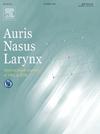Impact of gross extranodal extension into major neck structures on the prognosis of papillary thyroid carcinoma
IF 1.6
4区 医学
Q2 OTORHINOLARYNGOLOGY
引用次数: 0
Abstract
Objective
The AJCC-8 staging system for papillary thyroid carcinoma (PTC) excludes certain lymph node characteristics from stage determinants due to insufficient evidence of their prognostic impact. This study aimed to examine the influence of gross extranodal extension (N-Ex) on survival and recurrence by comparing outcomes of extrathyroidal extension (T-Ex) and N-Ex cases.
Methods
Patients with PTC who underwent initial surgical treatment and had T-Ex or N-Ex were selected. Their survival and recurrence rates were compared, focusing on age and stage classification. Patients younger than 55 years without distant metastasis (DM) are classified as Stage I, regardless of T-Ex or N-Ex. Patients aged 55 years or older without DM are classified as Stage II if they have N-Ex without T-Ex and Stage III or IVA if they have T-Ex. The prognoses of the T-Ex and N-Ex groups stratified by age were compared. Using the T-classification by organ involvement, older patients with N-Ex were subgrouped, and their prognoses were compared with those of the T-Ex group.
Results
The study included 183 T-Ex and 50 N-Ex without T-Ex cases. The disease-specific survival (DSS) and disease-free survival (DFS) of the two groups did not differ for the younger patients without distant metastases (Stage I in both groups). For the older patients without distant metastasis, the 10-year DSS was 80.6% and 48.5% for Stages III and IVA (with T4bAnyNM0; T-Ex group) and 74.7% for Stage II (with T1-3N-ExM0; N-Ex group). The 10-year DFS were 68.2%, 0%, and 64.5% for Stages III, IVA (T-Ex group), and II (N-Ex group), respectively. The DSS and DFS did not differ for Stages III and IVA (T-Ex group) and II (N-Ex group). The prognoses of the N-Ex subgroups and the older T-Ex group did not also differ.
Conclusions
The patients aged 55 years or older without DM had comparable prognoses, although cases with N-Ex without T-Ex were classified as Stage II, and those with T-Ex were classified as Stage III or IVA. The recurrence rates for the N-Ex and T-Ex stages were also comparable. These suggest that N-Ex is an important prognostic factor.
结外延伸到颈部主要结构对甲状腺乳头状癌预后的影响。
目的:甲状腺乳头状癌(PTC)的AJCC-8分期系统将某些淋巴结特征排除在分期决定因素之外,因为它们对预后的影响证据不足。本研究旨在通过比较甲状腺外展(T-Ex)和N-Ex病例的结果,探讨总结外展(N-Ex)对生存和复发的影响。方法:选择首次手术治疗并有T-Ex或N-Ex的PTC患者。比较两组患者的生存率和复发率,重点是年龄和分期。年龄小于55岁且无远处转移(DM)的患者被归类为I期,无论T-Ex或N-Ex。55岁及以上无DM的患者,如果有N-Ex而没有T-Ex,则分为II期;如果有T-Ex,则分为III期或IVA期。比较按年龄分层的T-Ex组和N-Ex组的预后。使用器官受累的t分类,对老年N-Ex患者进行亚组,并将其预后与T-Ex组进行比较。结果:共纳入T-Ex患者183例,N-Ex患者50例。对于没有远处转移的年轻患者(两组均为I期),两组的疾病特异性生存期(DSS)和无病生存期(DFS)没有差异。对于无远处转移的老年患者,III期和IVA期的10年DSS分别为80.6%和48.5% (T4bAnyNM0;II期(T1-3N-ExM0;N-Ex集团)。III期、IVA期(T-Ex组)和II期(N-Ex组)的10年DFS分别为68.2%、0%和64.5%。III期、IVA期(T-Ex组)和II期(N-Ex组)的DSS和DFS没有差异。N-Ex亚组和老年T-Ex组的预后也没有差异。结论:55岁及以上无DM的患者预后相当,尽管N-Ex不含T-Ex的患者被分类为II期,而T-Ex患者被分类为III期或IVA期。N-Ex期和T-Ex期的复发率也具有可比性。这表明N-Ex是一个重要的预后因素。
本文章由计算机程序翻译,如有差异,请以英文原文为准。
求助全文
约1分钟内获得全文
求助全文
来源期刊

Auris Nasus Larynx
医学-耳鼻喉科学
CiteScore
3.40
自引率
5.90%
发文量
169
审稿时长
30 days
期刊介绍:
The international journal Auris Nasus Larynx provides the opportunity for rapid, carefully reviewed publications concerning the fundamental and clinical aspects of otorhinolaryngology and related fields. This includes otology, neurotology, bronchoesophagology, laryngology, rhinology, allergology, head and neck medicine and oncologic surgery, maxillofacial and plastic surgery, audiology, speech science.
Original papers, short communications and original case reports can be submitted. Reviews on recent developments are invited regularly and Letters to the Editor commenting on papers or any aspect of Auris Nasus Larynx are welcomed.
Founded in 1973 and previously published by the Society for Promotion of International Otorhinolaryngology, the journal is now the official English-language journal of the Oto-Rhino-Laryngological Society of Japan, Inc. The aim of its new international Editorial Board is to make Auris Nasus Larynx an international forum for high quality research and clinical sciences.
 求助内容:
求助内容: 应助结果提醒方式:
应助结果提醒方式:


